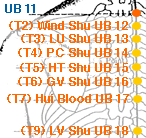UB 12
Acupuncture Point Theory
UB 12 Acupuncture Point Applications and Theory
 The acupuncture point "UB 12" , 風門, is represented by "Feng Men" in pinyin and "Wind Gate" in english and may be found:
The acupuncture point "UB 12" , 風門, is represented by "Feng Men" in pinyin and "Wind Gate" in english and may be found:
1.5 cun lateral to GV line, level with T2.
Of many possible clinical applications, it may be considered to influence the following issues/symptoms:
- Main point to expel wind from the Wei Qi level of the body, useful for early stages of wind-cold conditions (Common cold, cough, fever, headache, stiff neck).
- Apply moxa here and on ST 36 to strengthen the Wei Qi (or the defensive layer of the body). Strenghtening the defensive layer can increase resistance to colds and flus, but also stop the tendency of basic colds and/or flus from always going deeper in quickly, say to bronchitis or full blow sinus infections. These types of treatments should be done when the person is not sick.
Ub 12 has the following theoretical associations which serve as important guideposts in designing an effective treatment protocol:
- Intersection Point of the Urinary Bladder & Governing Vessel Channels
A single acupuncture point is not commonly thought of as an empirical way to influence a TCM diagnostic pattern. UB12, however, is a strong candidate to be incorporated into an acupuncture protocol for patients who exhibit: Lung Wind Invasion - Wind Cold
UB 12 may potentially be used, in coordination with a well designed acupuncture treatment protocol, to influence the following conditions: Common Cold, Cough, Fever, Headache and/or Neck Pain
While not necessarily valid clinically, EX Huatuojiaji at T2 (T2 innervates the bronchus and thymus gland and i…), SI 10 (Local point for shoulder and upper arm pain, swel…), SI 12 (Local point for shoulder, scapula and/or arm pain…), SI 13 (Local point for shoulder and/or scapular region p…) and UB 41 (Useful for dispelling cold and wind from the uppe…) are nearby.
All Content 1999-2025
Chad J. Dupuis / Yin Yang House
Our Policies and Privacy Guidelines
Our Affiliated Clinics
